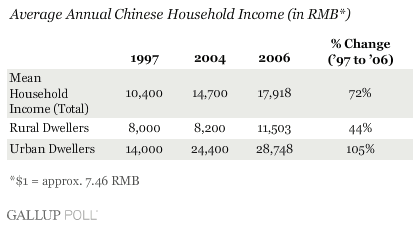IRVINE, Calif. -- China's GDP and the per-capita income of her citizens have increased impressively over the past decade. ÆéûÜǨû§surveys in China reveal that self-reported average household income grew more than 70% from 1997 to 2006, and that the income of the typical urban Chinese household more than doubled in that period. While the average urban household continues to enjoy income considerably higher than its rural counterpart, rural Chinese have also seen their incomes increase, particularly during the past few years.
Increasing incomes would appear to be good news for Chinese consumers and good news for marketers seeking to provide products and services to meet the needs of this seemingly more affluent market. But there's another trend that's at least as important as the change in household income: the increase in how much the average Chinese household requires to make ends meet in a world in which both costs and aspirations keep rising.

Making More ãÎ But Is It Enough?
Beyond the measure of self-reported household income, ÆéûÜǨû§Polls in China ask consumers about their household expenditures in areas ranging from food and rent to medical costs. There is also a summary question regarding how much income their families need for their basic requirements. The latter question measures not what Chinese consumers might wish for or dream about, but rather simply what they deem necessary to live their lives. Here the data are importantly revealing, as these increases often dwarf the growth in reported household income. While household incomes are up 72% since 1997, the average household's financial requirement "just to get by" has more than doubled in nine years. Together, the data reveal what is for many an important gap between household resources and household needs, a gap between how much money is available and how much is perceived as necessary. Businesses must take this gap into account when anticipating the likely future purchases of the Chinese consumer.
It should be noted that these impressive income increases, at least in the minds of the Chinese, are hardly discretionary. Incomes are viewed not in the absolute, but rather in comparison with what are judged to be household necessities. A decade ago, a refrigerator, a microwave, and an air conditioner most likely were not considered basic requirements. While these products still may not be deemed essential by every Chinese consumer, these consumers, both urban and rural, own far more household appliances and electronics than they did a decade ago. It appears that there has been a redefinition of household requirements, and what many now see as "basic" has changed substantially.

ÆéûÜǨû§Polls in China also reveal an important trend regarding the changing aspirations and expectations of rural and urban Chinese. Urban households may seem to have tempered their expectations (or personal requirements) during the past few years, bringing their household requirements into closer synch with their incomes. In clear contrast, rural Chinese households' expectations of the income they need to live their lives increased 45% in just two years. While rural Chinese household incomes averaged about 11,500 RMB in 2006, these rural dwellers feel they need 22% more than that "just to get by." These findings suggest rural Chinese have greatly redefined what they feel they absolutely must have, which now likely includes a color TV and a mobile phone. Products that rural Chinese once deemed luxuries are now seen as requirements. As a result, what people believe they need to get by is increasing at a rate faster than incomes.
The changing expectations and requirements among the Chinese are crucial considerations for any company seeking to market to them. After all, dreams and aspirations alone do not determine what will be purchased. The sometimes harsh realities of limited resources must also come into play. Importantly, the gap between income and requirements has not translated into markedly increased dissatisfaction. While there's a good deal of dissatisfaction with current incomes, that dissatisfaction hasn't been increasing much, despite the continuing income-vs.-requirements gap. In 1997, 45% of Chinese expressed some degree of dissatisfaction ("very" or "somewhat") with their household income. Nine years later, that level of dissatisfaction was only minimally higher (49%) and there were no differences in the dissatisfaction among rural and urban Chinese. Admittedly, there has been some decline in the percentage of Chinese indicating that they are "very" satisfied with their income (dropping from 9% in 1997 to only 3% in 2006).
The net result may be that, despite the apparent gap between income and requirements, Chinese consumers may recognize that they now possess a good deal more than they did a decade ago. They're neither thrilled nor particularly content with the income levels they've achieved. And yet their household glass, while not completely full, is certainly not empty. Nevertheless, it's apparent that many Chinese consumers are feeling a tighter economic pinch as they try to match their resources with their changing requirements. Product marketers will be challenged to do more than increase product availability. They must also seek to deliver product value to consumers who increasingly may be seeking better deals.
Survey Methods
Results are based on face-to-face interviews with more than 3,500 adults per year in China, aged 18 and older, conducted in 1997, 2004, and 2006. For results based on the total sample of national adults, one can say with 95% confidence that the maximum margin of sampling error is ôÝ2 percentage points. In addition to sampling error, question wording and practical difficulties in conducting surveys can introduce error or bias into the findings of public opinion polls.
